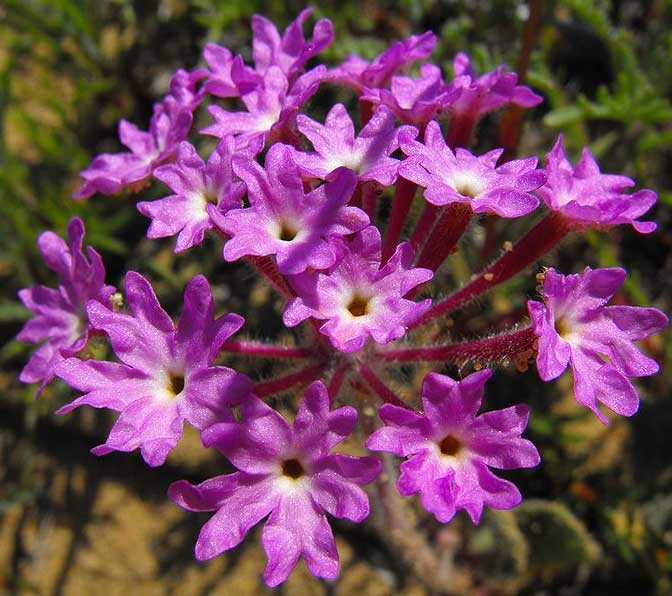
Abronia umbellata
Classification System: APG IV
Superregnum: Eukaryota
Regnum: Plantae
Cladus: Angiosperms
Cladus: Eudicots
Cladus: Core eudicots
Ordo: Caryophyllales
Familia: Nyctaginaceae
Tribus: Nyctagineae
Genus: Abronia
Species: Abronia umbellata
Subspecies: A. u. acutalata – A. u. breviflora – A. u. umbellata
Name
Abronia umbellata Lam., 1792
References
Tableau Encyclopedique et Methodique ... Botanique 1: t. 105. 1792; 1:469(text). 1793
USDA, ARS, Germplasm Resources Information Network. Abronia umbellata in the Germplasm Resources Information Network (GRIN), U.S. Department of Agriculture Agricultural Research Service. Accessed: 08-Apr-12.
Abronia umbellata – Taxon details on Integrated Taxonomic Information System (ITIS).
Vernacular names
English: Pink Sand Verbena, Beach Sand Verbena, Purple Sand Verbena
русский: Аброния зонтичная
Abronia umbellata (pink sand verbena) is a flowering annual plant which is native to western North America. Other common names include beach sand verbena and purple sand verbena.
Distribution
This plant is generally found in sandy, well-drained soil in areas with low precipitation, it can become a striking carpet-like groundcover in undisturbed areas after winter rains. Pink sand verbena tolerates seaside conditions and is found on the west coast of North America from British Columbia, Canada to Baja California, Mexico. Sand verbena is typically found on beaches and sand dunes, below the coastal sage scrub, blooming throughout most of the year.[2][3]
Description
Abronia umbellata is a prostrate annual with thick, succulent leaves (leaves occur few to many and are slender, ovate to diamond-shape with stems as long as leaf blades, stems are often hairy) and pink to purple colored flowers with white centers. Flowers occur in clusters subtended by 5-8 lanceolate bracts. The flowers do not have petals, but the calyx lobes are cleft giving the appearance of 10-16 petals. The limbs of the perianth is bright colored sometimes to purplish magenta and the tube can be green or red but always-glandular pubescent. The tube includes one pistil and three stamens.[4]
A. umbellata frequently hybridizes with other species of Abronia, including A. maritima. Its flower is fragrant at night and attracts moths. The foliage can be deciduous based on environmental stress. This plant is sometimes used in California in native plant gardening.[5]
History in Europe
Originally described in 1793 by the French botanist Jean-Baptiste Lamarck,[6] Abronia umbellata was collected in 1786 from Monterey, California by the gardener Jean Nicolas Collignon of the French La Pérouse expedition, which had stopped at the capital of Alta California as part of a journey of scientific exploration spanning the Pacific Ocean. While Collignon and his shipmates perished in a wreck near Vanikoro in the Solomon Islands, some of his collection had previously been shipped back to France during a stop at the Portuguese-held Macao, including the seeds of A. umbellata. They were planted at the Jardin des Plantes in Paris, and Lamarck eventually named their descendants A. umbellata, making this species the first Californian flower that does not occur outside of western North America that was described in the scientific fashion of Linnaeus.[7]
References
The Plant List, Abronia umbellata Lam.
CalFlora taxon report, University of California: Abronia umbellata
Biota of North America Program 2014 county distribution map
Flora of North America: Abronia umbellata
Bailey, L. H. (2005). Manual of Gardening (Second Edition). Project Gutenberg Literary Archive Foundation.
Lamarck, Jean Baptiste Antoine Pierre de Monnet de 1793. Tableau Encyclopédique et Methodique ... Botanique 1(2[2]): page 469, plate 105
Beidleman, Richard G. (2006). California's Frontier Naturalists. University of California Press. ISBN 9780520927506.
Retrieved from "http://en.wikipedia.org/"
All text is available under the terms of the GNU Free Documentation License

